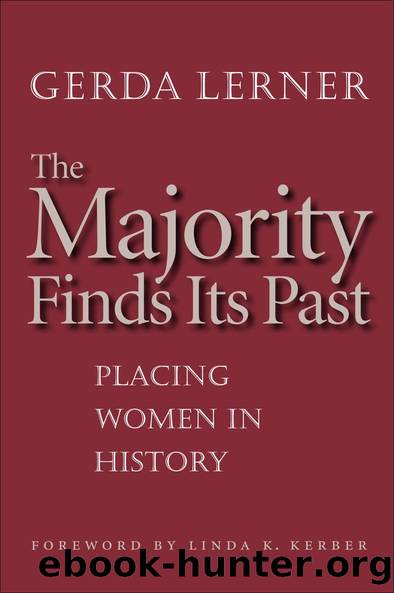The Majority Finds Its Past: Placing Women in History by Gerda Lerner

Author:Gerda Lerner [Lerner, Gerda]
Language: eng
Format: epub
Tags: Feminism, History
ISBN: 9781469617091
Google: n9BFAwAAQBAJ
Goodreads: 228483
Publisher: UNC Press Books
Published: 1979-01-01T00:00:00+00:00
8
The Political Activities of Antislavery Women
Historians of abolitionism have paid a great deal of attention to the ideas, the personalities, the psychological and political motivation of the abolitionists, and to the outcome of four decades or more of agitation. There has been relatively little interest in an institutional analysis of the antislavery movement except for the brief periods of dramatic dissension within the movement.1 Yet the phenomenon of a movement which began with the dedicated band of sixty-two people who formed the American Anti-Slavery Society in 1833 and went on to organize more than 1350 local societies in 1838; which in 1840 and 1844 entered politics with decisive, if negative, results and which had by 1860 so affected public opinion that a Republican could be elected President, deserves functional analysis.2 Regardless of whether abolitionism achieved its stated goals, there is no question that it served to transform public opinion on the issue of slavery in the North and the West and that it did so by a series of organized efforts with different tactical goals.
Antislavery workers and agitators labored in groups; their societies were local organizations and county and state networks; the anniversaries and conventions served organizational, educational, and public relations functions. To change public opinion, antislavery organizations had to be visible locally, have continuity and a recognizable public face, and had to carry on some form of propaganda and organizing work. Such work formed the basis for fund-raising, recruitment of forces, political campaigning, even the bringing of law suits. The important groundwork out of which political antislavery would grow was laid in the years 1836â43. Antislavery petition campaigns were an important aspect of this work. Women, who played a crucial role in antislavery petitioning, had far more importance in transforming public opinion and thereby influencing political life than has hitherto been recognized.
This essay is based on a paper delivered at the Southern Historical Association Meeting, Atlanta, November 11, 1976. The essay has benefited from the criticism of Professors Betty Fladeland, Eric Foner, James McPherson, Anne Firor Scott, Ronald Walters, and Peter Wood.
Quite in keeping with the general neglect of the history of women, the antislavery activities of women have been slighted by historians. In so far as women abolitionists were singled out for closer scrutiny, interest focused on a few individual âleaders,â their biographies and especially their psychology, with emphasis on their supposed deviance. Where organized female activity has been interpreted at all, historians have taken for granted the supposedly negative effect of the âwoman questionâ in splitting the American Anti-Slavery Society in 1840.3 Even historians of women have been more interested in the effect of antislavery activities on the rise of feminism than in the activities themselves.4
Men and women in the antislavery movement did not necessarily engage in the same activities nor approach their work in the same way. Thus the questions historians traditionally ask of their sources frequently fail to elicit material pertaining to the activities of women. Much antislavery historiography has been focused on leadership. Who
Download
This site does not store any files on its server. We only index and link to content provided by other sites. Please contact the content providers to delete copyright contents if any and email us, we'll remove relevant links or contents immediately.
| Africa | Americas |
| Arctic & Antarctica | Asia |
| Australia & Oceania | Europe |
| Middle East | Russia |
| United States | World |
| Ancient Civilizations | Military |
| Historical Study & Educational Resources |
Cecilia; Or, Memoirs of an Heiress — Volume 1 by Fanny Burney(32064)
Cecilia; Or, Memoirs of an Heiress — Volume 3 by Fanny Burney(31459)
Cecilia; Or, Memoirs of an Heiress — Volume 2 by Fanny Burney(31409)
The Secret History by Donna Tartt(18168)
Sapiens: A Brief History of Humankind by Yuval Noah Harari(13993)
Leonardo da Vinci by Walter Isaacson(12807)
The Radium Girls by Kate Moore(11624)
Sapiens by Yuval Noah Harari(5125)
How Democracies Die by Steven Levitsky & Daniel Ziblatt(4965)
The Wind in My Hair by Masih Alinejad(4847)
Homo Deus: A Brief History of Tomorrow by Yuval Noah Harari(4691)
Endurance: Shackleton's Incredible Voyage by Alfred Lansing(4508)
Man's Search for Meaning by Viktor Frankl(4291)
The Silk Roads by Peter Frankopan(4275)
Millionaire: The Philanderer, Gambler, and Duelist Who Invented Modern Finance by Janet Gleeson(4105)
The Rape of Nanking by Iris Chang(4024)
Hitler in Los Angeles by Steven J. Ross(3800)
The Motorcycle Diaries by Ernesto Che Guevara(3788)
Joan of Arc by Mary Gordon(3786)
